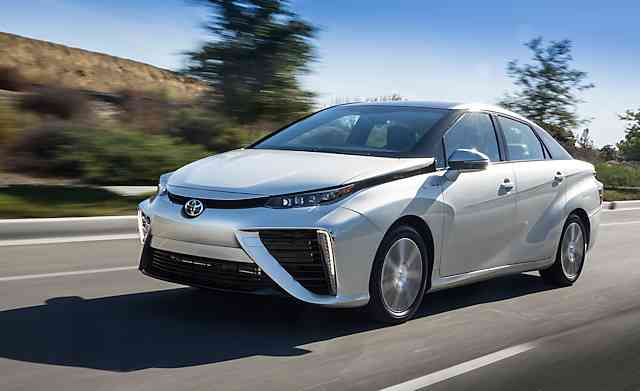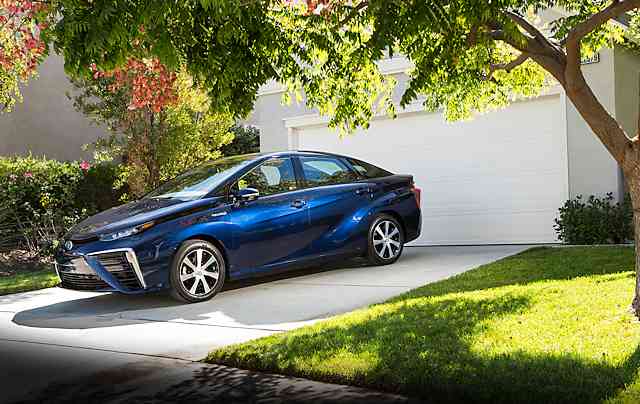Toyota Mirai
The Toyota Mirai is the first production vehicle from this venerable Japanese automaker to be powered by the hydrogen fuel cell. The Mirai was first officially revealed at the 2014 Los Angeles Auto Show.
 Toyota Mirai at 2014 Los Angeles Auto Show |
Currently, the plans are to build 700 vehicles under the Mirai name that went in production in December 2014 and are on sale in 2015. Of these 700, approximately 200 Mirais will be for sale in the United States.
|
“Mirai” means “future” in Japan and this vehicle represents what Toyota believes to be the future of car engine technology. The Mirai is expected to sell for roughly $57,500 when it is first released into the US which is scheduled to be in the summer of 2015. The UK, Denmark and Germany will start receiving the vehicles in September 2015 with the vehicle spreading to other countries sometime in 2017.


The History of the Mirai
The Mirai is based on the original FCV fuel cell concept car that was first featured at the 2013 Tokyo Motor Show. The vehicle certainly made an impression with its teardrop shape which emphasizes the fact that it was being powered by the hydrogen found inside of water. The FCV features a large grille and other openings which helped keep the engine cool. In addition, the FCV had a range of 430 miles before it needed refueling.

The FCV was similar in size to the Toyota Camry and became the basis for the Mirai concept which has varied from the water-based design to a certain degree. Plus, advances in fuel cell technology have greatly reduced the cost of the engine which is just 5-percent of the cost of the 2008 Toyota FCHV vehicle. The FCV also includes an electric motor which is charged by the power of the fuel cell and acts in support of the engine when in operation.
As the FVC was being finalized into the Mirai design, Toyota began plans to market the vehicle to the general public. However, such plans needed to wait until enough hydrogen refueling stations became available in the country before the Mirai could be considered a practical solution. This means that the vehicle will not be introduced until at least March or April, 2015 in Japan.

Safety Issues
While the hydrogen itself presents no real danger, the fact that the two hydrogen tanks are pressurized initially raised some concerns just like other fuel systems such as propane need pressurization to work in car engines. However, the carbon fiber reinforced plastic hydrogen tanks are extremely tough, durable and impact resistant. This means the force to puncture the tanks would exceed most impact situations. Toyota proved this in January 2014 by firing both small caliber bullets and large caliber 50mm armor piercing bullets into the H2 tanks. There was no explosion or fire with either weapon.
The emphasis on safety has led to extensive testing to fully realize the extent of how the hydrogen tanks respond to impacts and the results that have come in has led to the advancement in tank construction technology.

The Toyota Mirai will be the true test market vehicle for the company to see if the hydrogen fuel concept is truly viable. Its future will depend on the cost of the vehicle and the availability of hydrogen fuel around the country.
Toyota Mirai Specifications
- Uses hybrid and fuel cell technology
- Powered by Toyota Fuel Cell System and PC boost convertor
- Fuel cell stack output is 153 hp
- 0 – 60 mph acceleration in 9.0 seconds
- Refueling time: 3 to 5 minutes
- Range is 312 miles
- Contains two 10,000 psi carbon fiber polymer fuel tanks
- NiMH rechargeable battery pack
- 152 hp electric traction motor
Videos on How the Mirai is being made
More Info
Check out more info about the Toyota Mirai on our blog.
Here is info about the Toyota FCV Concept
Here is info about the Toyota FCV-R Concept
Here is more info about the Toyota FCVH
External Link
From the Toyota Newsroom
FAQs about the Toyota Mirai – https://ssl.toyota.com/fcv-content/faq.html
Images
All Images Photo Courtesy Toyota Motor Corporation except for top photo at Los Angeles Auto Show which is courtesy Kevin Kantola
Written by Hydro Kevin Kantola
Any who could think that this technology is not the best invention ever made by Humans, to conserve this Planet. Is Mentally brainwashed gasoline, kerosene, by Rockefeller.